Is Kinner Kailash and Shrikhand Mahadev Same
“ Kinner Kailash ≠ Shrikhand Mahadev — but here’s why both peaks hold their own spiritual might, hidden myths, and pilgrimage paths that often get confused. By the end of this post, you’ll know exactly how to distinguish them and understand which trek is right for you.”
Kinner Kailash, also known as Kinnaur Kailash, is a mountain peak located at 15,000 ft above sea level in the Kalpa region of Kinnaur district, in the northern state of Himachal Pradesh, India.
Shrikhand Kailash, well known as Shrikhand Mahadev, is a mountain peak at 17150 ft above sea level in the Nirmand region, district Kullu, in the northern state of Himachal Pradesh, India.
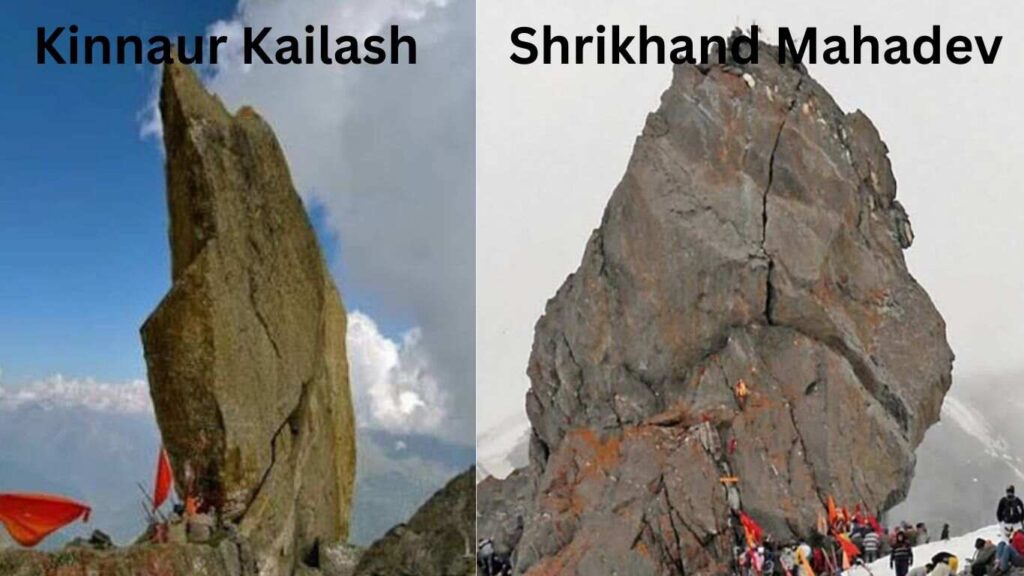
Both mountains are characterized by their striking resemblance to the iconic “SWAYAMBHU” Shiva Lingas, with towering peaks and distinct ridges creating a mesmerizing visual.
Quick-Scan Comparison Table
| Feature | Kinner Kailash | Shrikhand Mahadev |
| Location | Kalpa, Kinnaur (4,650 m) | Nirmand, Kullu (5,230 m) |
| Shivalinga | Natural Shiv lingam (~79 ft) | Natural Shiv lingam (~72 ft) |
| Difficulty | Moderate–Strenuous | Strenuous, glacier crossing |
| Trek Duration | ~5–6 days | ~6–7 days |
| Best Time | 15 July–31 August 2025 | 10 July–23 July 2025 |
| Registration | Himachal Pradesh portal (₹250) | Himachal Pradesh portal (₹250 + fitness certificate) |
What is Kinner Kailash
Kinner Kailash or Kinnaur Kailash is a peak situated in the upper region of the Great Himalayan range in Himachal Pradesh. The mountain has a 79-foot-tall Swayambhu Shiva linga at an elevation of 15,000 feet. Kinner Kailash is one of the five Kailash, the fourth in terms of importance.
Kinner Kailash is accompanied by various natural wonders like natural glaciers, lakes, fields filled with rare flowers, and natural caves that provide shelter for pilgrims and shepherds.
Parvati Bagh is famous for the rare “Brahm Kamal” flower, believed to have been seeded by Goddess Parvati. The area is named after the Goddess Parvati.
Kinner Kailash is believed to be the resting abode of the mighty Hindu lord Shiva and Mata Parvati. The Kinner tribe, who reside in Kinnaur, were blessed by lord Shiva, who made this peak his resting abode. Honoured by having lord Shiva in their area, the tribe became devotees of lord Shiva, and after some time, the peak was named after the tribe “KINNER KAILASH”.
Kinnaur Kailash, also known as Kinner Kailash, holds immense spiritual significance for both Hindus and Buddhists.
The Kinners are also believed to have been the guardians of the sacred Kinnaur Kailash, protecting its sanctity and ensuring that only the most worthy pilgrims were granted access to the mountain. The local Kinnauri people still revere their ancestral deities and the sacred landscapes they inhabited.
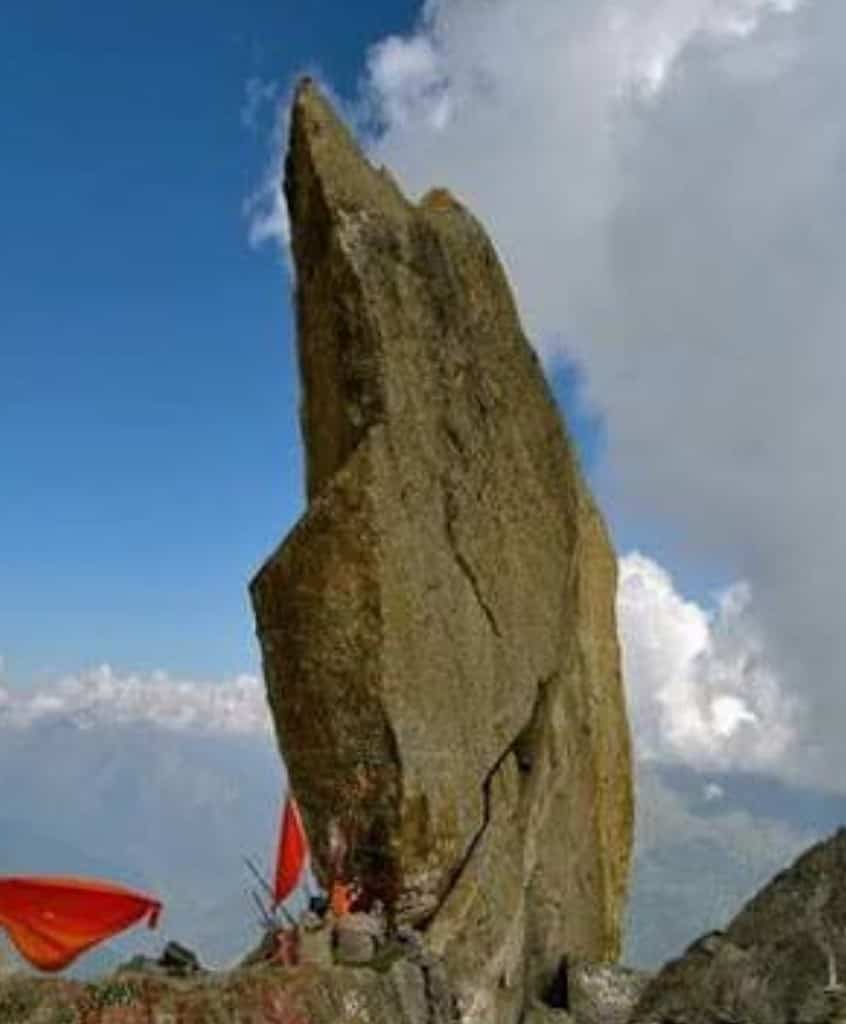
Registration – The pilgrims must register first to visit Kinner Kailash. The registration can be done on the official Himachal Pradesh government website.

Where is Kinner Kailash
Kinner Kailash Kailash well known as Kinnaur Kailash, is in the Kalpa region of district Kinnaur in the Himalayan state of Himachal Pradesh at a height of 15000 feet in the deep and upper Himalayan region near the Indo-Tibetan border.
What is Shrikhand Mahadev
Shrikhand Mahadev is believed to be the abode of Lord Shiva, where he meditated for a long time after getting disturbed by Bhasmasur’s treachery on this 72 ft Shivalinga.
Shrikhand Mahadev is a mountain peak 17150 feet above sea level in Himachal Pradesh, believed to be the place where lord Shiva meditated for a long time. Shrikhand Mahadev holds an immense spiritual value in the Hindu Dharma.
In the Vaidik times (Satyug), there was a rakshas named “BHASMASUR” who did very hard penance and got a boon from lord Shiva that if he places his hand on anyone’s head, he/she would burn immediately.
After getting the boon, he went on trying it on lord Shiva to test the boon. Lord Vishnu came in the form of a “MOHINI” and hypnotised Bhasmasur with his tremendous singing and dancing that Bhasmasur started dancing with her, forgot about the boon, put his hand on his own head while dancing, and died right there.
But Lord Shiva got disturbed by the feeling of giving the boon to the wrong person, and then he disappeared from there and hid in the area for a long time to meditate.
Shrikhand Mahadev or Shrikhand Kailash is the third in terms of importance among the Five Kailash. The peak is near the Indo-Tibetan border area and is considered to be the hardest Kailash to reach due to the longest trek.
To reach Shrikhand Mahadev, pilgrims must register on the Himachal Pradesh official website. Pilgrims should be physically fit and also need to get a medical certificate.
Demon King Ravan Story – The Shrikhand word was made out by adding two words, “Sir Khandan”, “Sir” Means “Head”, and “Khandan” means rebuttal or dissection. There is a story about Ravan that once demon king Ravan did a penance here and cut off his head as an offering to please the lord Shiva, and this is how he got the boon of conditional immortality.
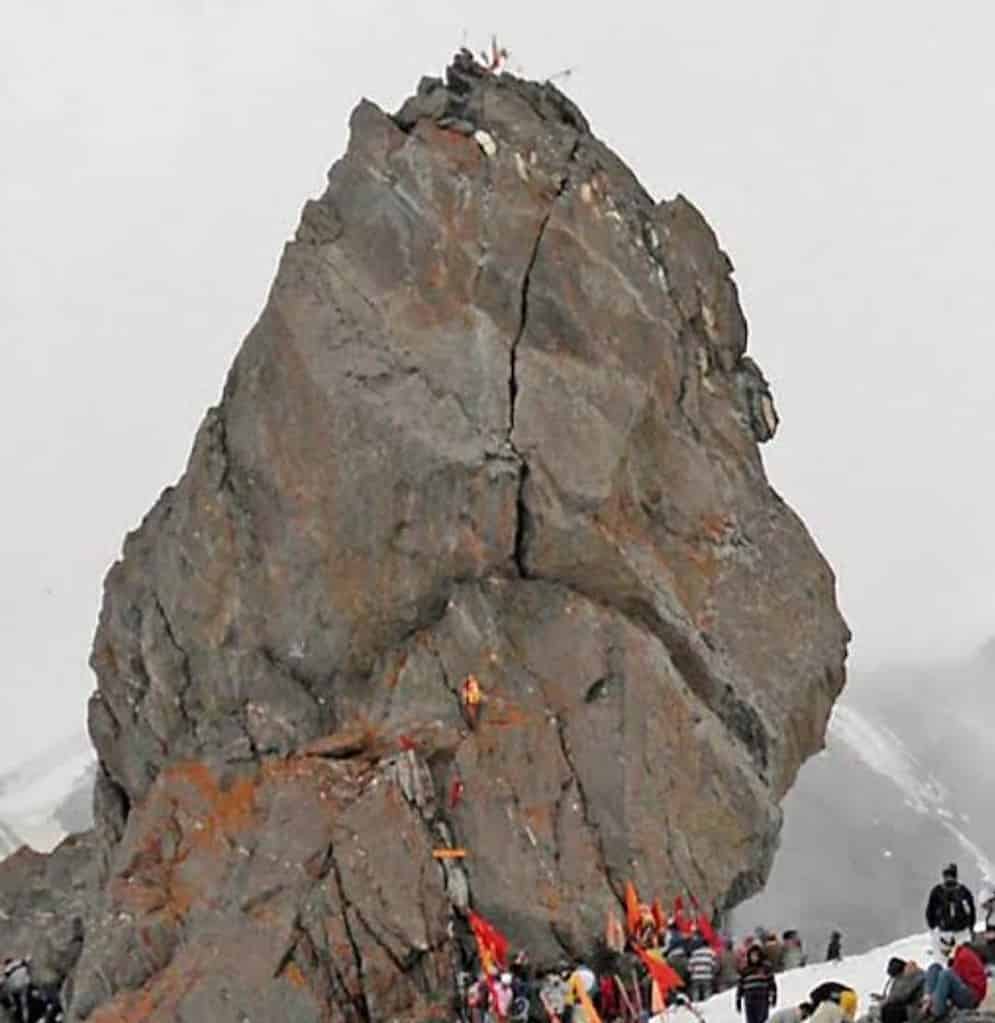
Registration – You have to register yourself to visit Shrikhand Kailash, or the officials may get you deported from any base camp. You can register for the yatra on the official Himachal Pradesh portal; the fee to register is only 250 Rs per person.
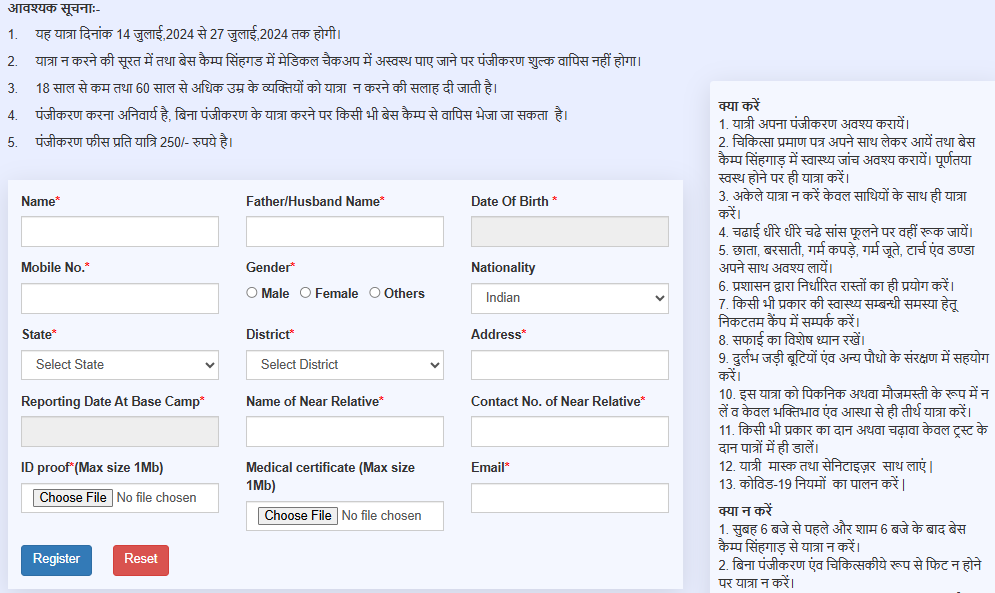
Where is Shrikhand Kailash
Shrikhand Kailash well Known as Shrikhand Mahadev, is in the Nirmand region of district Kullu in the Himalayan state of Himachal Pradesh at the height of 17150 feet in the deep and upper Himalayan region near the Indo-Tibetan border.
Shrikhand Mahadev is surrounded by various natural wonders, including natural glaciers, lakes, fields filled with rare flowers, and natural caves that provide shelter for pilgrims and shepherds.
Shrikhand Kailash Bheem Dwar red water
There is a place in the Shrikhand Kailash trek named Bheem Dwar. It is believed that Bheem killed Bakasur Rakshas here when the Pandavas were living in the “EKACHAKRA”(an old city). Hence, the water is still red here because of that Rakhshasa’s blood.
Why Kinner Kailash is famous
Spiritual Significance – Kinner Kailash holds immense spiritual significance for both Hindus and Buddhists. This sacred mountain is revered as an abode of Lord Shiva, the supreme deity in Hinduism, and is believed to be a manifestation of the celestial Mount Kailash in the Tibetan Himalayas.
Pilgrims from across India and beyond flock to Kinnaur Kailash to seek the blessings of the divine couple and to participate in the various religious rituals and festivals held in their honor.
The spiritual significance of Kinnaur Kailash extends beyond Hinduism, as it is also revered by Buddhists. The mountain is believed to be the abode of Demchok, a wrathful deity associated with the Vajrayana branch of Buddhism. Buddhists from the neighboring regions of Spiti and Ladakh often embark on pilgrimages to Kinnaur Kailash, seeking spiritual enlightenment and the blessings of the divine.
One of the Kailash – The Kinner Kailash is one of the Panch Kailash Parvat. In terms of importance, it is the fourth Kailash. First is Kailash Mansarovar, and Adi Kailash is second, Shrikhand Mahadev is third, and Mani Mahesh Kailash is fifth.
79-foot-high Shivalinga – On the top of Kinner Kailash mountain, there is a 79-foot-high Shivalinga that is the main attraction and center point of this Yatra. This Shivalinga changes its colour during the day.
Why Shrikhand Mahadev is famous
There are so many reasons why the Shrikhand Mahadev is famous, I will not be able to explain them all. Some of them you may already know, but here are a few.
Spiritual significance – Shrikhand Mahadev holds immense spiritual value in the Hindu dharma as the abode of lord Shiva and Goddess Parvati.
One of the Panch Kailash – Shrikhand Mahadev is one of the Panch Kailash series along with Kailash Mansarovar, Adi Kailash, Kinner Kailash, and Mani Mahesh Kailash.
Toughest Kailash – Shrikhand Mahadev is the toughest trek and hardest to reach among the Panch Kailash.
72-foot-high Shivalinga – There is a 72-foot-high Shivalinga on the top of the mountain at 17150 ft above sea level.
It is believed that Lord Shiva meditated for a long time after getting disturbed by Bhasmasur’s treachery on this 72 ft Shivalinga.
One of the hardest treks – This trek also attracts so many tourists and trekkers because of the challenge it poses to the hikers and trekkers. Shrikhand Mahadev offers one of the highest altitude treks in India, which is widely open for everyone.
How Kinner Kailash and Shrikhand Mahadev look like
Kinner Kailash and Shrikhand Mahadev are both different peaks, but look so much alike, and both have the Swayambhu “SHIVALINGA” on the top of the mountain. This is one of the many reasons why these mountains are so sacred and worshipped in the Hindu dharma.
However, Kinner Kailash and Shrikhand Mahadev are two different yatra. The 75-foot-high Shivalinga on Shrikhand Mahadev Peak on the top of a 17150-foot mountain and 79 feet 79-foot-high Shivalinga on the Kinner Kailash Peak on the top of a 15000-foot mountain are considered Swayambhu Shivalingas. The face of Lord Shiva is depicted by this gigantic Shivaling, complete with matted hair, eyes, and nose.
How Many Kailash are there
There are five Kailash in total. It is believed that lord Shiva lived, visited, or stayed at these five peaks at one time or another, which is why these five peaks have their significance in Hindu Dharma. Kinner Kailash and Shrikhand Mahadev are among them.
Five Kailsh or Panch Kailash have their spiritual value in Hindu Dharma as the living or visiting place of lord Shiva unlike five Kedar where Lord Shiva took the form of a buffalo and is worshipped in the various forms inside the temples like well known “KEDARNATH” temple, all Kailash Parvats are mountains, not temples and hold the value as a mountain whereas Panch Kedar and Twelve Jyotirlingas are temples.
Panch Kailash name
There are five Kailash in the world. Together they are called “Panch Kailash”. Panch is a series of five sacred mountains first is Kailash Mansarovar, the second is Adi Kailash, the third is Shrikhand Mahadev, the fourth is Kinner Kailash, and the fifth is Mani Mahesh Kailash.
- Kailash Mansarovar – Tibet
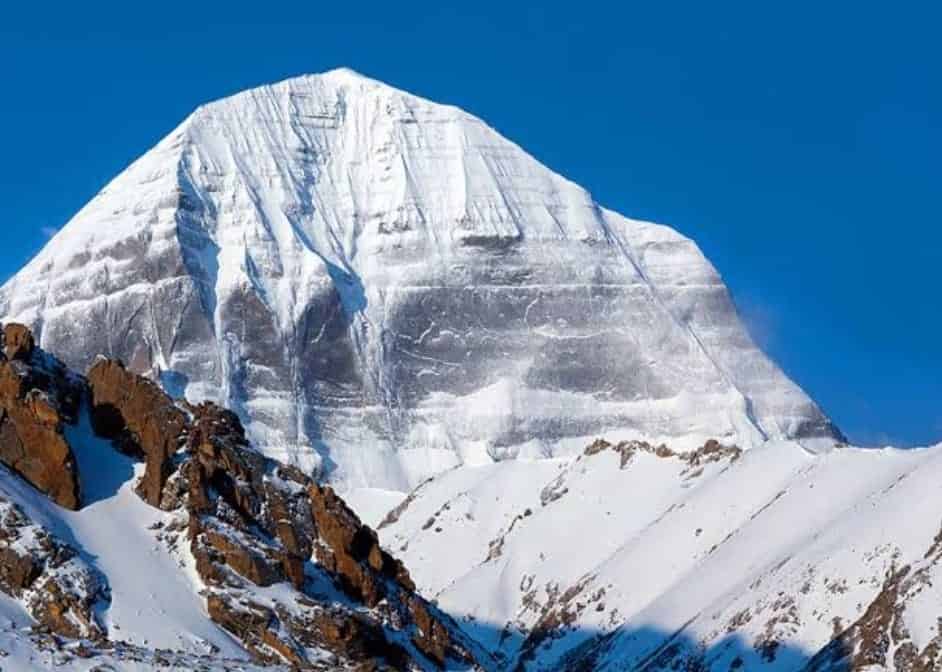
Kailash Mansarovar China
Kailash Mansarovar, also known as Mount Kailash, is a Mountain peak in the upper Himalayan region of Tibet(China). Mount Kailash holds immense value in various religions as well as to scientists and adventure seekers.
Mount Kailash is in the Burang country area, at a height of 6638 meters above sea level in Tibet(China).
First in the Panch Kailash and the only one outside India, Mount Kailash is believed to be the home of the mighty Hindu lord Shiva in Hindu Dharma.
- Adi Kailash – Uttarakhand, India.
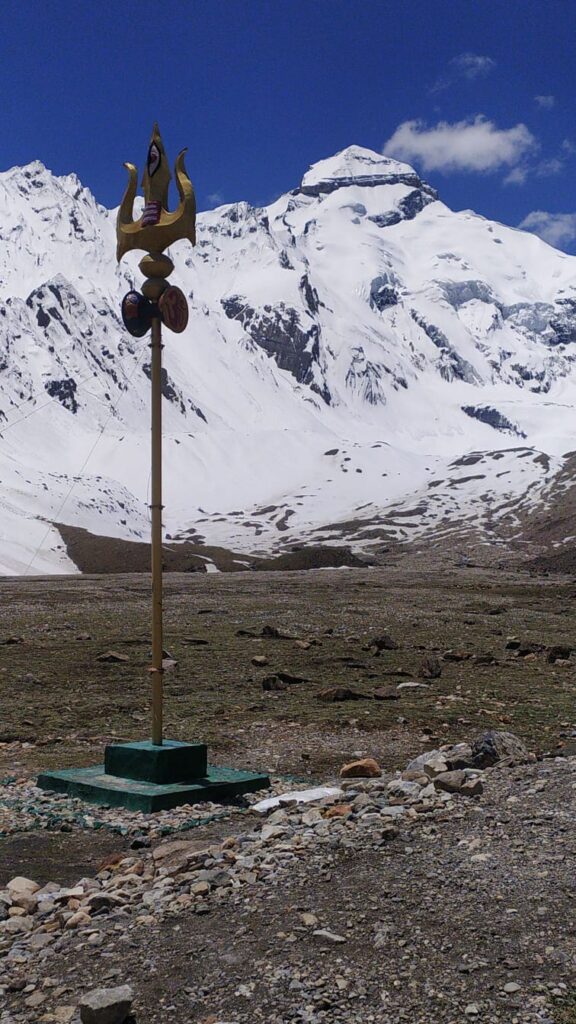
Adi Kailash Jolingkong
“ADI” is a Hindi word that means “THE FIRST,” and Kailash is the abode of lord Shiva, which means the First abode of lord Shiva. Adi Kailash is a mountain peak second in Panch Kailash, at an altitude of 5945 meters in the district Pithoragarh, Kumaon region of Uttarakhand, India. Adi Kailash, also known as Chhota Kailash, holds immense spiritual value in Hindu dharma as the abode of lord Shiva.
Adi Kailash is a mountain peak shaped like a Shivalinga in the upper Himalayan region. It is a replica of Mount Kailash or Kailash Mansarovar of Tibet(China). Sometimes people get confused between them; these two mountains are not the same, and there is a lot of difference between Adi Kailash and Kailash Mansarovar.
- Shrikhand Kailash – Himachal Pradesh, India.

Shrikhand Mahadev is a mountain peak 17150 feet above sea level in Himachal Pradesh, believed to be the place where lord Shiva meditated for a long time. Shrikhand Mahadev holds an immense spiritual value in the Hindu Dharma.
- Kinner Kailash – Himachal Pradesh, India.

Kinner Kailash or Kinnaur Kailash is a peak situated in the upper region of the Great Himalayan range in Himachal Pradesh. The mountain has a 79 ft tall Swayambhu Shiva linga at an elevation of 15000 ft. Kinner Kailash is one of the five Kailash, the fourth in terms of importance.
- Mani Mahesh Kailash – Himachal Pradesh, India.
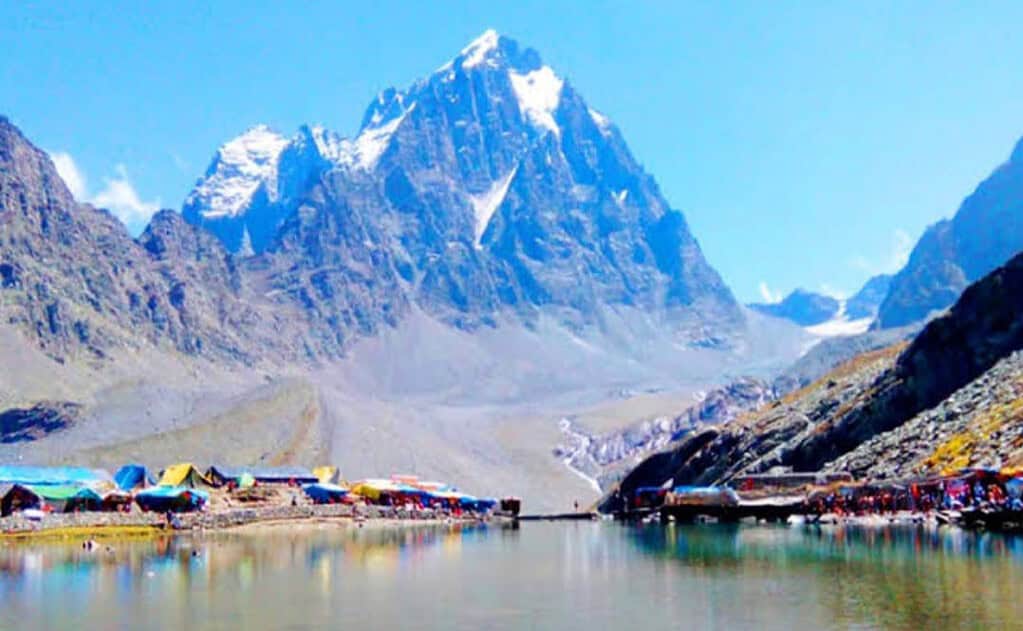
Mani Mahesh Parvat and Lake
Mani Mahesh Kailash, also known as Chamba Kailash, is in the Pir Panjal range of Chamba district in Himachal Pradesh at 13390 feet above sea level. There is a lake which is also named after the Mani Mahesh Kailash, called Mani Mahesh Lake.
Mani means “GEM”, and Mahesh is one of the names of lord Shiva. This mountain is called Mani Mahesh Kailash because of a phenomenon that occurs in the morning when the Sun rises from behind the mountain, the Sun’s rays come to the lake area through a cavity in the mountain and create the effect of a “SHINING GEM”.
What to Pack for Kailash Yatra (with Essential Trekking Gear)
Packing smart for Kailash Yatra is not just about convenience—it’s about comfort, safety, and survival at high altitude. Here’s a list of essential items I personally use or recommend, based on multiple Yatras in all seasons.
Trekking Shoes (Top Priority!)
If there’s one item that can make or break your Yatra, it’s your shoes.
Avoid sports shoes. You need proper trekking shoes with ankle support, grip, and water resistance.
Recommended Picks
- Budget Trekking Shoes (Rs. 1000–2500)
- Mid-Range Waterproof Hiking Boots
- Premium All-Weather Trekking Shoes
I’ve used these on the various Kailash Yatra trails during peak rains and slushy patches—and my feet thanked me every step.
Rain Jackets, Ponchos & Windcheaters
The weather in any Kailash, whether Shrikhand Mahadev or Kinnaur Kailash, can turn from sunny to stormy in minutes.
Must-Pack Rain Gear:
- Reusable Rain Poncho (Unisex) – Lightweight and Compact
- Windproof & Waterproof Jackets – For Cold & Rain
- Rain Pants for Trekking – Stay Dry Waist-Down
Pro Tip: Pack a disposable raincoat as backup.
Thermals, Gloves, and Layered Clothing
Even in summer, mornings can feel icy.
Suggested Items:
- Thermal Set for Men/Women – Soft & Breathable
- Woolen Gloves + Touchscreen Friendly Options
- Fleece Jacket (Optional Mid-layer)
Layer smartly: base thermal + fleece + jacket.
Head Torch or Flashlight
In remote areas, power cuts are common and trails can be pitch-dark early morning.
Best Options:
Energy Snacks, Dry Fruits, and Hydration
Long treks demand quick energy. I usually carry:
- Energy Bars (Chocolate/Nut Mix)
- Packaged Trail Mix or Dry Fruits
- Insulated Water Bottle or Hydration Pouch
Tip: Hydrate regularly to fight altitude fatigue.
Essential Health & Safety Kit
Never skip these:
- Basic First Aid Kit + Pain Relief Spray
- AMS (Altitude Sickness) Tablets – Consult Doctor First
- Sanitizer, Wet Wipes & Toilet Paper
Power Backup, ID Proof & Essentials
Keep your devices alive and your documents handy:
My Real Tip:
Don’t go overboard with gear, but don’t skip the essentials either. Good shoes and rain protection aren’t luxuries—they’re survival tools on this Yatra.
Whether you’re doing the Kedarnath Dham Yatra in summer heat or monsoon chill, these items can be the difference between a peaceful journey and a painful one. I’ve curated this list based on what I—and countless fellow pilgrims—use on the trail.
Pro Tip:
In the mountains, especially in high-altitude mountain trekking, 3 things alone, durable and high-quality Shoes, Jackets, and Rain Gear, can save your life.
Why Kailash Mansarovar is not in India
According to Hindu mythology, in ancient times, the whole Himalayan range was called Kailash, dedicated to Lord Shiva, and it was part of Bharat(India). Mount Kailash Mansarovar is believed to be the home of Lord Shiva. The mountain is now in Tibet after several partitions of the Sub-Indian continent.
When and how Kailash Mansarovar became part of China
As per recent history, Mount Kailash was never part of India, although the presence of Mount Kailash in the old Hindu scriptures, such as the Skanda Purana and Shiva Purana, has been mentioned many times.
There are two stories about Mount Kailash going into Chinese control.
- The area of Mount Kailash was ruled by the Nepali King, who gave it to the Tibetan King as the dowry for his daughter’s marriage. In 1950, when China invaded Tibet, Mount Kailash went into China.
- Mount Kailash was in the Nepali kingdom, and Nepal lost it to China during the Sino-Nepal War, also known as the Sino-Gorkha War, in 1972.
Is Kailash Mansarovar visible from India
Yes, Mount Kailash is visible from India. Visitors can see the mountain area from the old Lipu Lekh Pass in Uttarakhand. 30°14’11.0″N 81°01’35.4″E
- Story
Recently, some local people of Vyas Valley along with some trekkers and tourists in Uttarakhand claimed to see Mount Kailash or Bada Kailash from “LIPU LEKH” a mountain pass in Uttarakhand’s Vyas Valley near Nabhi Dhang After their claim went viral in the area and on social media it was later confirmed affirmatively by the Indian army and other officials.
- Accessibility
To see Mount Kailash, pilgrims reach Nabhi Dhang first and trek for 1 km. To get to Lipu Lekh pass at an altitude of nearly 18000 feet, this spot provides a breathtaking, majestic view of Mount Kailash.
Does time move faster on Mount Kailash
Although there is no machine or way to measure that if time is moving slower or faster but almost all people, including pilgrims, tourists, climbers, mountaineers, and even some scientists who have visited Mount Kailash have reported that their hair and nails have grown faster than normal, almost the equivalent of one month in five to seven days.
Conclusion
This article is supposed to clear the confusion and question what the difference is between Kinner Kailash and Shrikhand Mahadev, and to provide you with some known and unknown facts about the two mountains.
I hope I have answered all your questions regarding the confusion about the Kinner Kailash and Shrikhand Mahadev, which often confuses people. I would love to have you on board and gladly consider any suggestions or corrections in the comments.

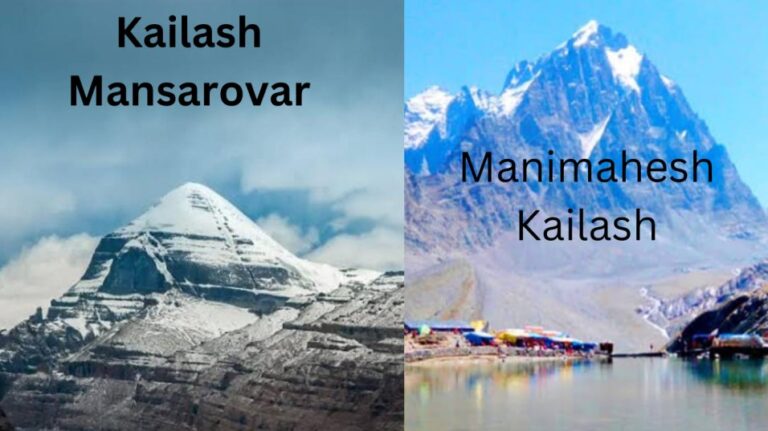
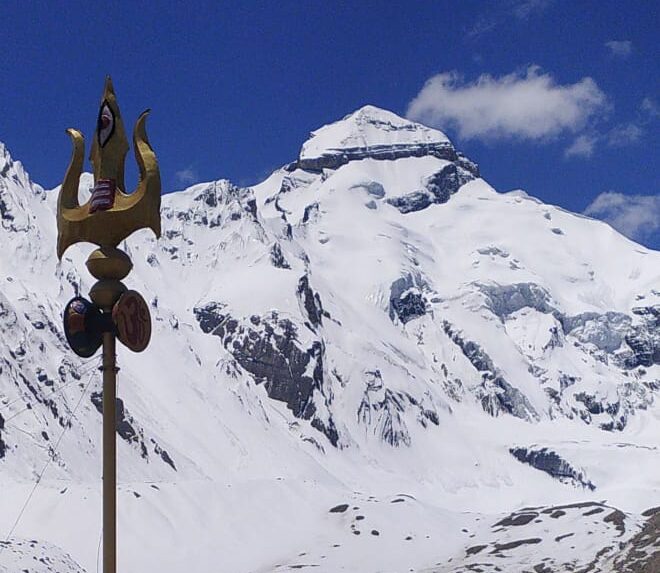
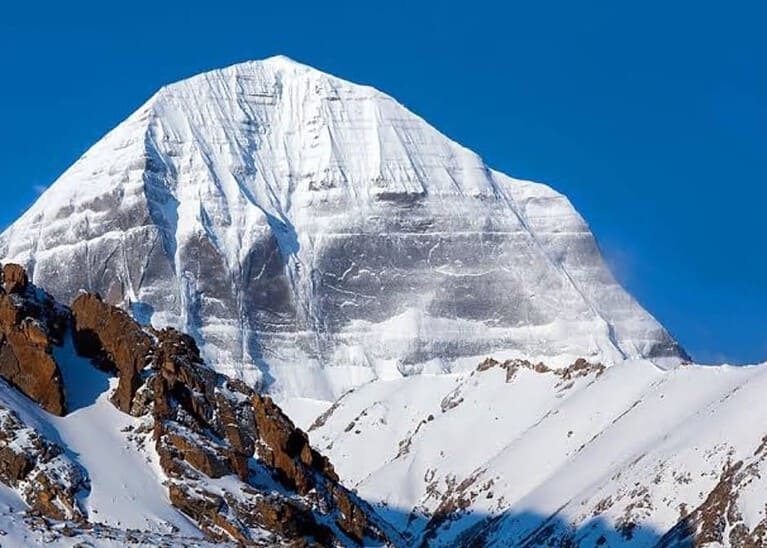
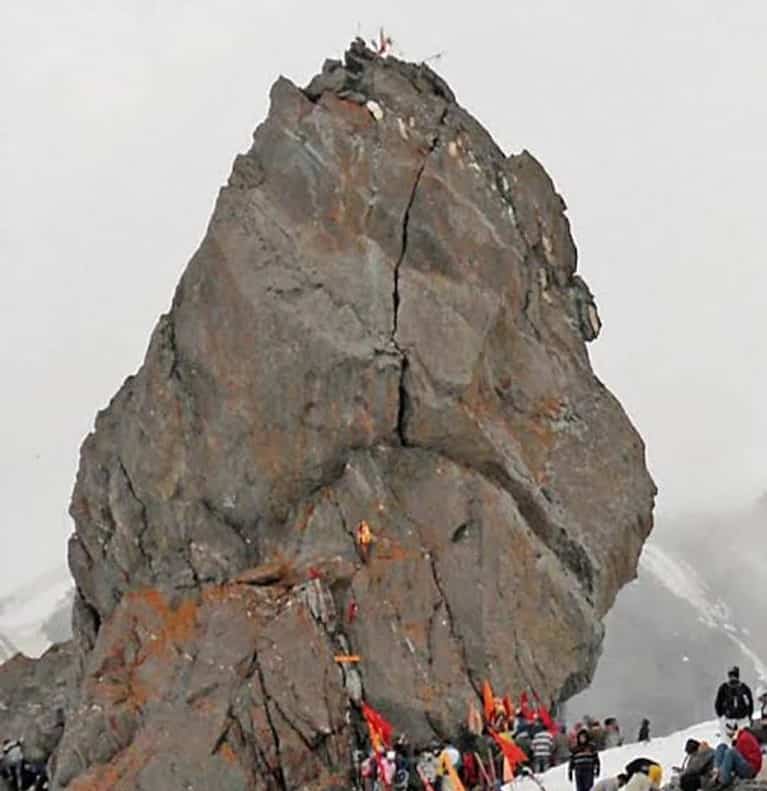
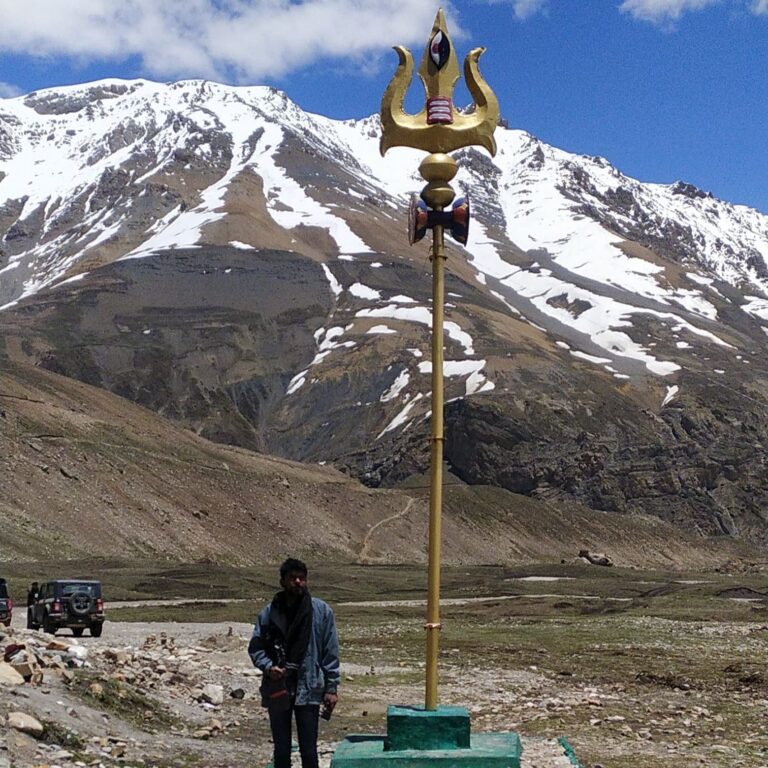
This is incredibly informative—thank you for clearing up the confusion between Kinner Kailash and Shrikhand Mahadev. Loved the blend of mythology, geography, and spiritual insight. A great read for anyone planning the yatras or just curious about the Panch Kailash!
A well-researched and insightful article! The clear distinction between Adi Kailash and Kailash Mansarovar, along with historical and spiritual context, enhances understanding for both pilgrims and trekkers. Looking forward to more informative pieces like this!
Thank You so much, you guys are being a leader yourself in the field and still admiring me is something that is giving me the motivation.